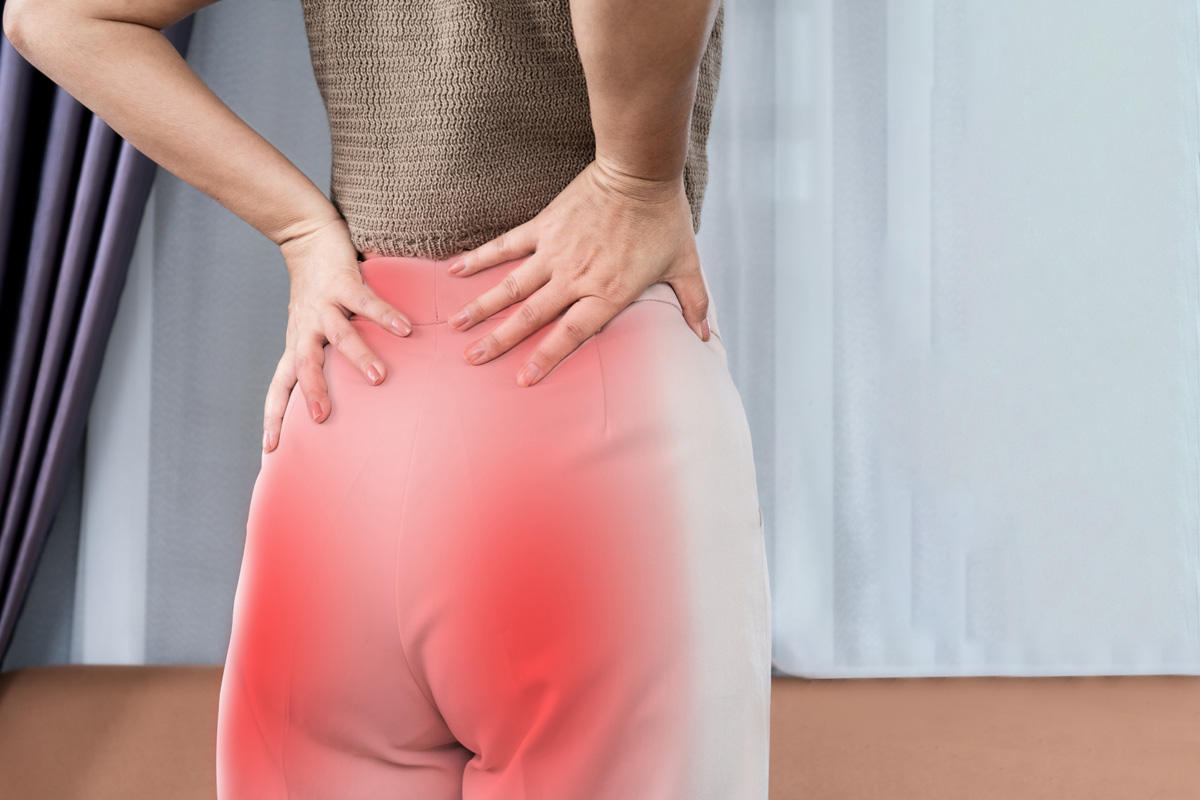Sciatica, a condition characterized by pain radiating along the sciatic nerve, can be debilitating for many. The myriad of treatment options available – from physical therapy to over-the-counter medications – often leave individuals overwhelmed. Yet, by understanding the root causes and symptoms of sciatica, as well as the efficacy of various treatment modalities, one can devise an effective, personalized pain relief strategy. What are the most effective practices for managing sciatica pain and how can these be seamlessly integrated into daily routine? Let’s explore.
Understanding Sciatica
To effectively combat sciatica, one must first grasp the intricacies of this common yet complex condition that primarily affects the lower back and leg. Understanding sciatica begins with debunking the prevalent Sciatica Misconceptions and Sciatica Myths that often cloud the perception of this ailment.
Despite common belief, sciatica is not a medical condition in itself, but rather a symptom of various underlying health issues. This is a critical misconception to dispel, as it directly influences the approach to treatment. Another widespread myth involves the notion that sciatica only affects the elderly. While it is true that the risk increases with age, even young adults can suffer from it due to factors like sedentary lifestyles or heavy physical activity.
Moreover, sciatica is often mistaken for general back pain. The key distinguishing feature is the pain pathway, which in sciatica, travels from the lower back, through the hip and buttock area, down one leg. Misunderstanding this can lead to ineffective treatment strategies.
Common Causes of Sciatica
Sciatica, a condition often characterized by pain that radiates along the path of the sciatic nerve, can be sparked by several common triggers. One primary cause is a herniated disc in the spine, which can apply pressure to the nerve and instigate discomfort. Another notable cause is lumbar stenosis, a narrowing of the spinal cord in the lower back that can compress the sciatic nerve.
Identifying Sciatica Triggers
Understanding the common triggers of sciatica, which typically include factors like herniated discs, bone spurs, and spinal stenosis, is an essential step towards effective pain management. However, other less recognized triggers can also contribute to sciatica pain. Surprisingly, diet can be a significant factor. A poorly managed diet that prompts inflammation can exacerbate sciatica symptoms. This is known as the ‘Sciatica diet impact’. Foods high in sugars and unhealthy fats, for instance, can trigger inflammation leading to sciatic nerve irritation.
Additionally, emotional stress can aggravate sciatica. The ‘Emotional stress connection’ to sciatica is increasingly being recognized by clinicians. Chronic stress can tense muscles, which may compress the sciatic nerve, causing pain. Identifying these triggers can guide preventative measures and treatment strategies.
Role of Herniated Discs
While diet and emotional stress can certainly contribute to sciatica pain, herniated discs are among the most common physical causes of this condition. A herniated disc occurs when the soft jelly-like center of a spinal disc pushes through a crack in the tougher exterior casing. This can irritate the nearby nerve roots, leading to sciatica pain. Disc degeneration impact with age can also increase the risk of disc herniation. It is therefore important to focus on disc herniation prevention. This includes maintaining a good posture, regular exercise to strengthen the core muscles, and avoiding lifting heavy objects improperly. It is important to note that while herniated discs are a common cause of sciatica, they are not the only cause. Other spinal conditions can also lead to this debilitating pain.
Influence of Lumbar Stenosis
Lumbar stenosis, a narrowing of the spinal canal in the lower back, represents another common physical cause of sciatica pain. This condition usually stems from the wear-and-tear changes that occur due to osteoarthritis. The resulting compression on the sciatic nerve triggers the characteristic radiating pain, numbness, or weakness. For severe cases of lumbar stenosis, stenosis surgery may be recommended. This procedure aims to relieve the pressure on the spinal cord or nerves, reducing the symptoms of sciatica. Posture correction is also an integral part of managing lumbar stenosis. Maintaining a good posture, either while sitting or standing, can greatly help minimize the pressure on the spinal cord, thereby alleviating the intensity of sciatica pain.
Symptoms of Sciatica
Sciatica, typically marked by pain radiating along the path of the sciatic nerve, can present a range of symptoms that vary greatly in intensity and duration. Most commonly, individuals may experience persistent pain on one side of the lower body, including the rear, leg, and sometimes even the foot. This discomfort, often likened to a burning sensation, can be aggravated by extended periods of sitting. Additionally, numbness or weakness in the leg or foot may occur, potentially leading to difficulty in moving the foot or leg.
Certain factors can exacerbate sciatica symptoms, including diet and pregnancy. A diet high in inflammatory foods can worsen sciatica pain, emphasizing the importance of a well-balanced, anti-inflammatory sciatica diet for managing symptoms. Pregnancy-related sciatica is another common condition, as the growing uterus can put pressure on the sciatic nerve, causing pain and discomfort.
The severity of sciatica symptoms can fluctuate, with certain individuals experiencing excruciating pain, while others may report only mild discomfort or numbness. Regardless of the intensity, sciatica symptoms can be a significant obstacle to daily activities, underscoring the necessity for effective pain management strategies.
When to Seek Medical Help
Recognizing the right time to seek professional medical assistance for sciatica symptoms is crucial in preventing further complications and promoting ideal recovery. The persistence and progression of certain symptoms are clear emergency indicators that require immediate medical attention.
- Severe pain: Sciatica usually causes mild to moderate discomfort, but extreme pain that impedes daily activities should not be ignored.
- Progressive neurological symptoms: If you notice an increase in weakness in your legs or worsening numbness and tingling, it could suggest a more serious underlying issue.
- Loss of bowel or bladder control: This is an alarming symptom that needs immediate attention, as it may indicate cauda equina syndrome, a rare but serious condition.
- Symptoms present in both legs: Sciatica typically affects one side of the body. If symptoms are present in both legs, this could denote a severe problem.
In these instances, a healthcare provider will determine if surgical intervention is needed. Remember, prompt action can prevent irreversible damage and enhance the effectiveness of treatment strategies. Therefore, understanding when to seek medical help is crucial, and can potentially save you from long-term discomfort or disability.
Diagnosis of Sciatica
In the process of diagnosing sciatica, healthcare professionals typically conduct a thorough evaluation that includes a detailed medical history and physical examination to identify the root cause of the pain. This in-depth assessment is crucial to differentiate sciatica from other conditions with similar symptoms.
Understanding the patient’s medical history and lifestyle can help identify potential Sciatica Risk Factors. These may include age, profession, obesity, prolonged sitting, and diabetes. Each of these factors can contribute to nerve damage and the development of sciatica.
The physical examination often involves tests to evaluate muscle strength, reflexes, and pain or numbness that radiates down the leg when the patient performs certain movements. In some cases, advanced imaging techniques like MRI or CT scans may be employed to confirm the diagnosis and identify potential Sciatica Complications, such as nerve damage or spinal stenosis.
Non-Invasive Treatments for Sciatica
Non-invasive treatments for sciatica offer a range of options that can alleviate discomfort without resorting to surgery. These treatments can be broadly categorized into home remedies and professional therapies, each with its own set of methodologies and effectiveness. It is essential to examine these treatments in detail to understand their benefits and potential limitations in managing sciatica pain.
Home Remedies for Sciatica
If you’re seeking relief from sciatica pain, there are several non-invasive home remedies you might consider to alleviate discomfort and enhance your overall well-being. Acupressure techniques and bed selection are among the practical measures you can incorporate into your daily routine.
- Acupressure Techniques: By applying pressure to specific points on your body, you can stimulate nerves and muscles to relieve pain and tension.
- Bed Selection: A firm, supportive mattress can greatly improve your sleep quality and reduce sciatic pain.
- Heat/Cold Therapy: Alternating hot and cold compresses can help to reduce inflammation and soothe painful areas.
- Physical Activity: Regular exercise, particularly gentle stretching, can help to alleviate pain and strengthen the muscles that support your spine, offering long-term benefits.
Professional Therapies Explored
Beyond the scope of home remedies, professional therapies offer a variety of non-invasive treatment options for individuals suffering from sciatica. One effective approach is through spinal adjustments, conducted by licensed chiropractors to realign the vertebrae, thereby reducing nerve irritability responsible for inflammation, muscle spasms, pain, and other symptoms associated with sciatica.
Another popular therapy involves various massage techniques, which help to relax muscles, improve circulation, and stimulate the body’s production of natural painkillers. Therapeutic massage can release tight lower back muscles that can press on the sciatic nerve. While the pain relief from such sessions may be temporary, regular massage can help reduce the frequency and intensity of sciatica symptoms. These therapies, in conjunction with a personalized treatment plan, can provide substantial relief.
Exercises to Relieve Sciatica
A plethora of gentle exercises can be beneficial in alleviating the discomfort associated with sciatica, with many specifically designed to strengthen the lower back and abdominal muscles. Among these exercises, Pilates and Yoga have shown significant effectiveness.
Pilates benefits include improved flexibility, balanced muscular strength, and enhanced core stability. It also promotes better posture, an important factor in alleviating sciatica pain. The movements in Pilates target the deep muscles of the abdomen and spine, thereby reducing the pressure on the sciatic nerve.
Yoga’s effectiveness lies in its ability to stretch and strengthen muscles while also improving posture and alignment. Certain yoga poses can provide immediate relief from sciatic pain. It also promotes a sense of calm and stress relief, which can indirectly impact on pain.
Here are four exercises to help relieve sciatica:
- Pilates Single Leg Stretch: This targets the core muscles and promotes spinal stability.
- Yoga Pigeon Pose: It aids in stretching the hip rotators and flexors.
- Knee to Chest Stretch: This helps to stretch the lower back.
- Spinal Twist: It aids in relieving tension and stiffness in the lower back and hips.
Remember to consult with a healthcare professional before starting any new exercise regimen.
Medication Options for Sciatica
Several important medication options are available for managing and alleviating the symptoms of sciatica, each with its own unique mechanism of action and potential side effects. Over-the-counter drugs like NSAIDs (Non-Steroidal Anti-Inflammatory Drugs) such as ibuprofen, can lessen inflammation and pain. Prescription medications, including muscle relaxants, narcotics, tricyclic antidepressants, and anti-seizure medications may also be used depending on the severity of the symptoms.
However, it’s essential to note that medication options for sciatica may vary for certain demographics, particularly pregnant women and the obese. Sciatica during pregnancy may require more caution, as some medications could pose risks to the fetus. Hence, consultation with a healthcare professional is indispensable before initiating any medication.
The impact of obesity on sciatica is also notable. Increased body weight can exacerbate sciatic pain, making effective medication even more critical. However, certain medications may have weight-related side effects, necessitating a careful balance between pain management and weight control.
While medications can provide relief, they are often part of a broader treatment plan which could include physiotherapy or surgery. Always consult with a healthcare professional to understand the best treatment plan for your individual case.

Alternative Therapies for Sciatica
In addition to conventional medical treatments, several alternative therapies can be effective in managing sciatica pain, offering a holistic approach to this debilitating condition. These therapies not only aim to alleviate pain but also aim for overall well-being.
- Acupuncture: The benefits of acupuncture are well-recognized in the domain of pain management. It stimulates specific points on the body to promote healing and pain relief. For sciatica, it targets points that unblock energy pathways in the lower back and legs, easing the nerve pain.
- Yoga: The effectiveness of yoga in relieving sciatica pain lies in its ability to stretch and strengthen the muscles supporting the spine. Certain poses like the pigeon pose or the reclining hand-to-big-toe pose can provide relief from sciatic discomfort.
- Chiropractic adjustments: Chiropractors use spinal adjustments to realign the spine, reducing pressure on the sciatic nerve. This can provide immediate relief from intense pain.
- Massage therapy: Deep tissue massage can help loosen the muscles in the lower back, relieving the compression of the sciatic nerve.
These alternative therapies, when combined with traditional care, can create a holistic therapeutic strategy for managing sciatica.
Lifestyle Changes for Sciatica Management
Beyond incorporating alternative therapies, making specific adjustments to daily habits can also play a significant role in managing and mitigating sciatica pain. These modifications can range from dietary adjustments to changes in sleep patterns, all aiming to reduce inflammation and discomfort associated with the condition.
Dietary adjustments are important for maintaining overall health and managing sciatica. An ideal diet for sciatica sufferers includes foods rich in anti-inflammatory properties, such as fruits, vegetables, lean proteins, and whole grains. Maintaining a healthy weight can help alleviate the pressure on the sciatic nerve. Conversely, avoiding foods that cause inflammation, such as processed foods and those high in sugar, can help keep sciatica symptoms at bay.
Sleep patterns also have a significant impact on managing sciatica pain. Establishing a regular sleep schedule, ensuring a comfortable and supportive sleeping environment, and practicing good sleep hygiene can all contribute to alleviating pain. Proper sleep allows the body to rest and recover, thereby reducing pain and inflammation.
Preventing Future Sciatica Flare-ups
To prevent future episodes of sciatica, proactive preventive measures, emphasizing overall body health, regular exercise, and proper posture, are vital. This approach is essential in maintaining the health of your spine and reducing the risk of sciatica flare-ups.
Here are four key strategies to contemplate:
- Regular Exercise: Engage in activities that strengthen your core muscles. This will provide better support for your spine, reducing the strain on the sciatic nerve.
- Proper Posture: Make sure you maintain good posture when sitting and standing. This will help to keep your spine aligned, reducing the pressure on your sciatic nerve.
- Sciatica Supporting Footwear: Invest in footwear that offers good arch support and cushioning. Ill-fitting or unsupportive shoes can lead to misalignment of the spine, potentially triggering sciatica.
- Weight Management Strategies: Implement a healthy diet and regular exercise regime to maintain a healthy weight. Excess weight can put additional strain on your spine, increasing the risk of sciatica.
Frequently Asked Questions
Can Sciatica Affect My Ability to Perform Daily Tasks?
Yes, sciatica can impact your ability to perform daily tasks. The pain and discomfort may affect your exercise routine and posture, which are essential elements in completing regular activities efficiently and without additional strain.
Can Weather Changes Worsen My Sciatica Pain?
Weather changes can indeed exacerbate sciatica symptoms. Through a weather impact analysis, it’s observed that cold, damp conditions often trigger seasonal flare-ups. However, individual responses to weather changes may vary greatly.
Does Sciatica Pain Affect Sleep Quality?
Yes, sciatica pain can indeed affect sleep quality. Incorrect sleeping positions can aggravate the condition, causing discomfort. Regular exercise can alleviate symptoms and improve sleep. Consult a healthcare professional for personalized management strategies.
Can Sciatica Lead to Permanent Nerve Damage?
Yes, severe untreated sciatica can potentially lead to permanent nerve damage. However, with early detection, nerve damage prevention is possible to avoid serious sciatica complications like loss of sensation or motor function.
Are There Specific Diets Recommended for People With Sciatica?
There are no specific diets for sciatica, however, incorporating anti-inflammatory foods and maintaining proper hydration can help manage inflammation and promote overall nerve health, potentially reducing the severity of sciatica symptoms.


